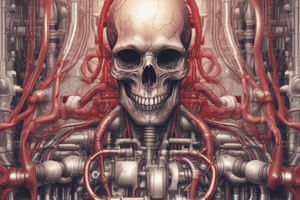Podcast
Questions and Answers
What happens to the partial pressure of oxygen around tissues when you exercise?
What happens to the partial pressure of oxygen around tissues when you exercise?
- It remains constant at 100 mmHg
- It stays at 60 mmHg
- It increases above 100 mmHg
- It drops to below 40 mmHg (correct)
What is the percentage of hemoglobin saturation at 100 mmHg PO2?
What is the percentage of hemoglobin saturation at 100 mmHg PO2?
- 100%
- 90%
- 80%
- 97% (correct)
What happens to the oxyhemoglobin dissociation curve when alveolar PO2 decreases to 60 mmHg?
What happens to the oxyhemoglobin dissociation curve when alveolar PO2 decreases to 60 mmHg?
- It remains unchanged (correct)
- It shifts to the right
- There is a significant change in % HbO2 saturation
- It shifts to the left
What is the effect of an increase in temperature on the oxyhemoglobin dissociation curve?
What is the effect of an increase in temperature on the oxyhemoglobin dissociation curve?
What happens to the O2 bound to hemoglobin when the oxyhemoglobin dissociation curve shifts to the right?
What happens to the O2 bound to hemoglobin when the oxyhemoglobin dissociation curve shifts to the right?
What is the effect of an increase in PCO2 on the oxyhemoglobin dissociation curve?
What is the effect of an increase in PCO2 on the oxyhemoglobin dissociation curve?
What happens to the pH during muscular exercise in skeletal muscle?
What happens to the pH during muscular exercise in skeletal muscle?
Why does hemoglobin give up more oxygen to the exercising muscle during muscular exercise?
Why does hemoglobin give up more oxygen to the exercising muscle during muscular exercise?
What is the effect of a rightward shift of the oxyhemoglobin dissociation curve on the exercising muscle?
What is the effect of a rightward shift of the oxyhemoglobin dissociation curve on the exercising muscle?
What happens to the dissolved oxygen level during muscular exercise in skeletal muscle?
What happens to the dissolved oxygen level during muscular exercise in skeletal muscle?
Flashcards are hidden until you start studying




